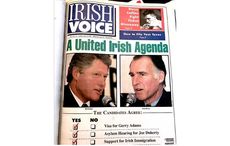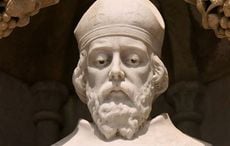Irish American gangster Jimmy “the Gent” Burke, and the crew that inspired the iconic Martin Scorsese film "Goodfellas," are in the news again.
Last week, the New York Daily News reported new details about a host of mobsters with ties to notorious crimes, including the legendary $6 million robbery – the Lufthansa Heist – Burke helped orchestrate at New York's Kennedy Airport.
“Federal prosecutors, in their most detailed disclosure to date about evidence against reputed capo Vincent Asaro, have revealed stunning secrets in the long-unsolved airport heist. The feds have lined up an impressive roster of rats with knowledge of Asaro’s participation in the [Lufthansa] heist,” the News reported.
This is only fitting because this year we celebrate – if that’s the right word for a flick about cold-blooded killers – the 25th anniversary of the release of "Goodfellas."
Meanwhile, later this month, the AMC cable network will begin airing an eight-part “docu-drama” exploring the creation of the New York City mafia. To be narrated by Ray Liotta, who played Irish-Italian gangster Henry Hill in "Goodfellas," "The Making of the Mob: New York" will feature interviews with prominent talking heads as well as action-packed recreations of the bloodshed that made headlines for generations.
The AMC mob special doesn’t begin airing until June 15. But early press material puts a lot of emphasis on Italians capos such as Lucky Luciano, Vito Genovese and Frank Costello (no, he’s not Irish; he was born Francesco Castiglia).
Since the suits over at AMC have eight hours of programming to fill, it can only be hoped that they – like Goodfellas – acknowledge the central role Irish American gangsters played in the creation of the Five Families as we have come to know them.
No, Irish hoods were not at the center of the most prominent crime families. But Irish American criminals played a key role – for better or worse – in how the underworld was organized.
A big part of this story begins in the Irish speaking region of Donegal, where Uinseann O Colla was born in 1908. After emigrating to the rough and tumble streets of the Bronx, Vincent Coll would earn the nickname “Mad Dog.”
Soon enough, Mad Dog and his brother Peter were working for bootlegger Dutch Schultz. As the 1920s wore on, and money was made and blood was spilled over illegal booze, Mad Dog became Dutch’s most trusted killer. They soon had a falling out, and Coll formed his own crew.
To finance his criminal activity – and prove just how crazy he was – Coll would kidnap fellow criminals and demand ransom payments.
Ethnic ties apparently meant little to Mad Dog. One of his kidnapping victims was “Big Frenchy” Demange, a close associate of Irish boss Owney Madden.
By September of 1931, Coll was known as a loose cannon, not to mention a gun for hire.
Italian kingpin Salvatore Maranzano had a falling out with one of his own associates, a fellow by the named of Charles “Lucky” Luciano. Maranzano even hired Mad Dog to kill Luciano, but the plot fell apart.
In fact, thanks to shifting alliances in the Italian and Jewish underworlds, it was Maranzano who ended up getting whacked in September of 1931. This resulted in Luciano becoming the criminal king of New York.
The close call with Coll convinced Luciano that the underworld needed to be better organized. The result was the formation of the so-called “Commission,” a group of underworld bosses who would meet regularly to settle conflicts that might normally have been settled with tommy guns and bloodshed.
The kind of chaos Mad Dog Coll often sowed was becoming bad for business. Not surprisingly, Coll himself was identified as a problem that needed to be solved.
Coll did something that almost no one else could do: he united Irish, Jewish and Italian mobsters, who all wanted him dead. On February 8, 1932, Coll was chatting with Owney Madden at a pay phone on Eighth Avenue and 23rd Street in Manhattan when several men barged into the pharmacy and riddled Coll’s body with bullets.
Vincent “Mad Dog” Coll was 23 years old.
We’ll see if Coll’s legacy – for better or worse – lives on in AMC’s "The Making of the Mob."
* Contact Sidewalks@tdeignan.blogspot.com.




Comments